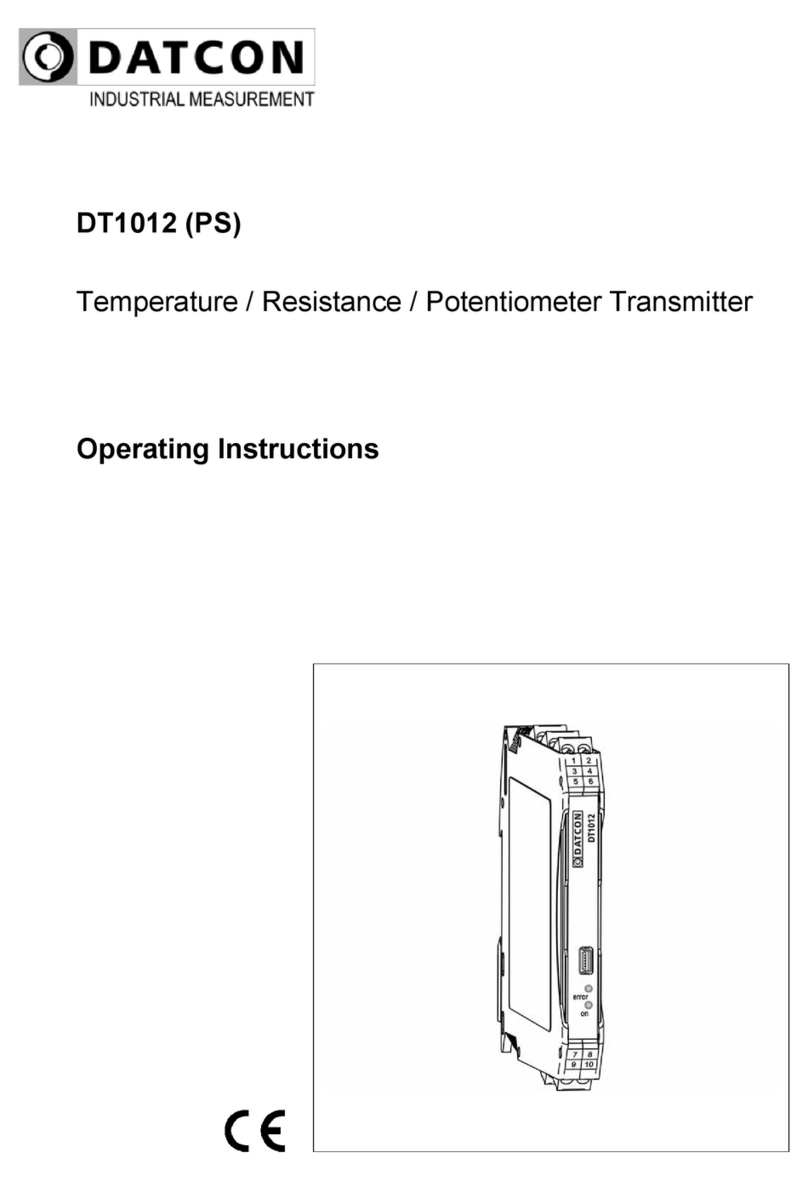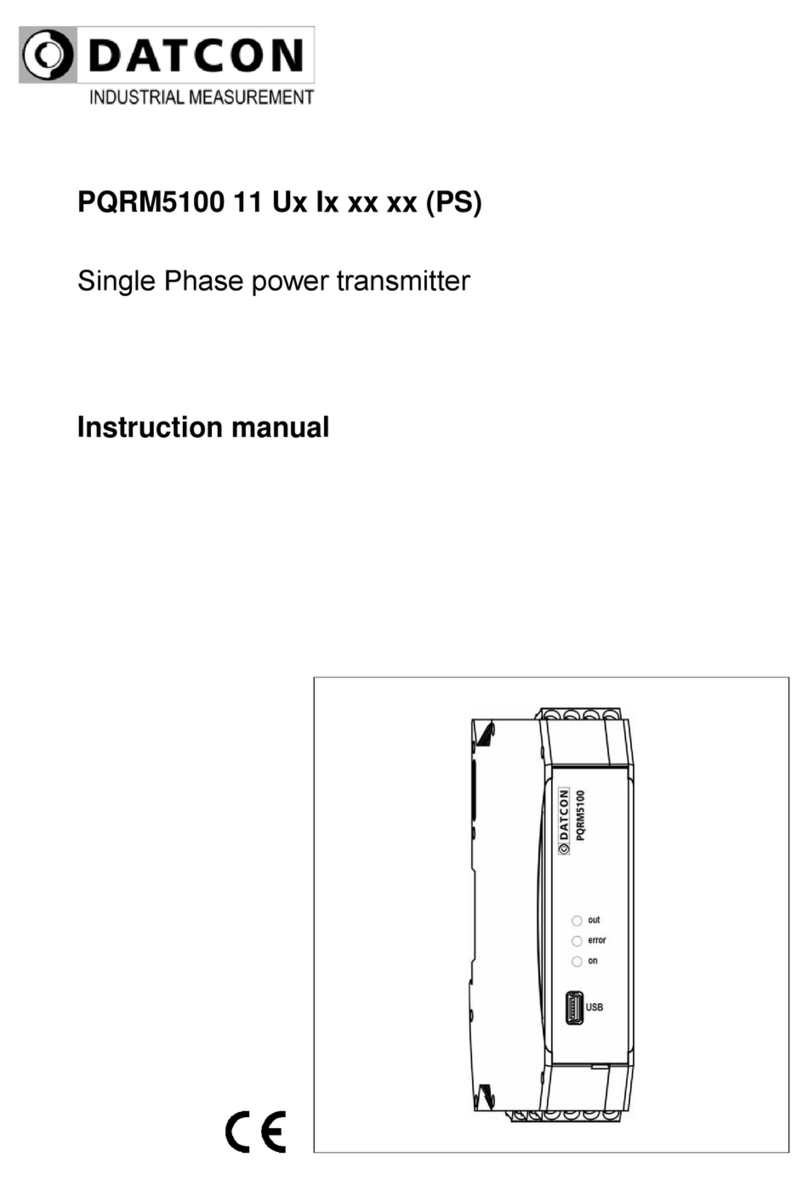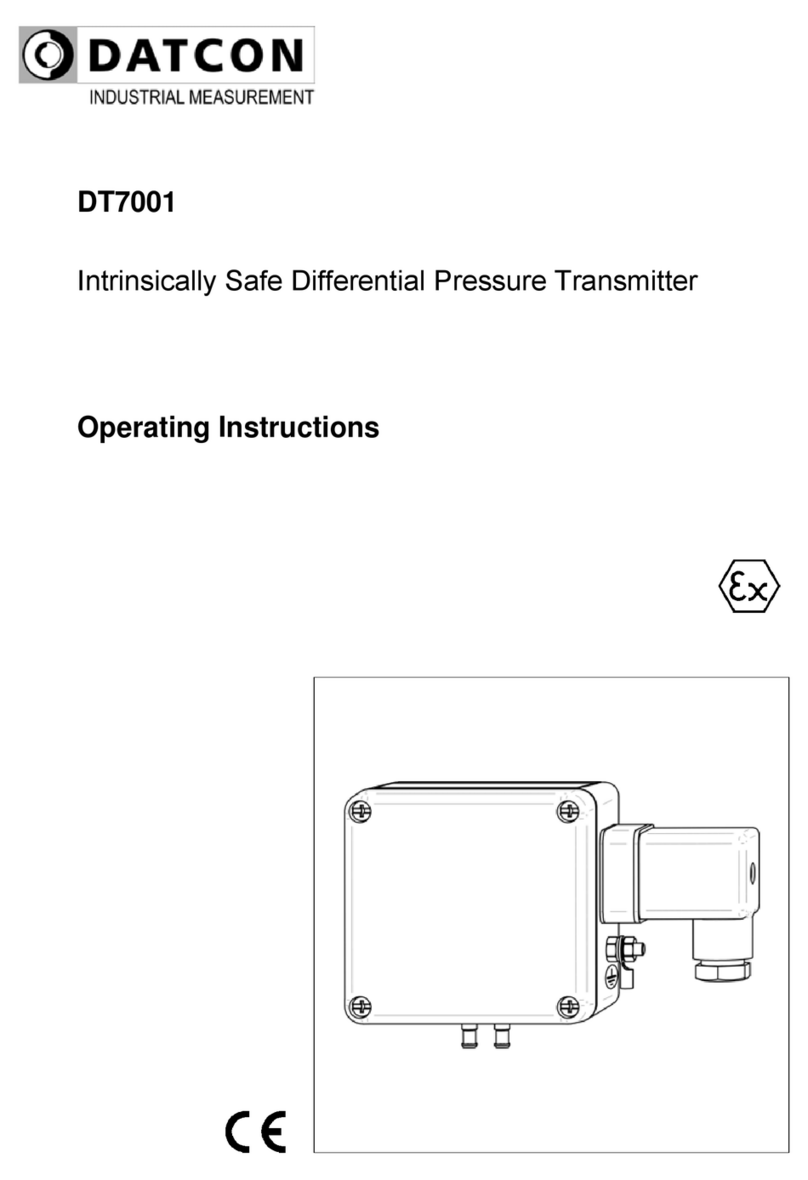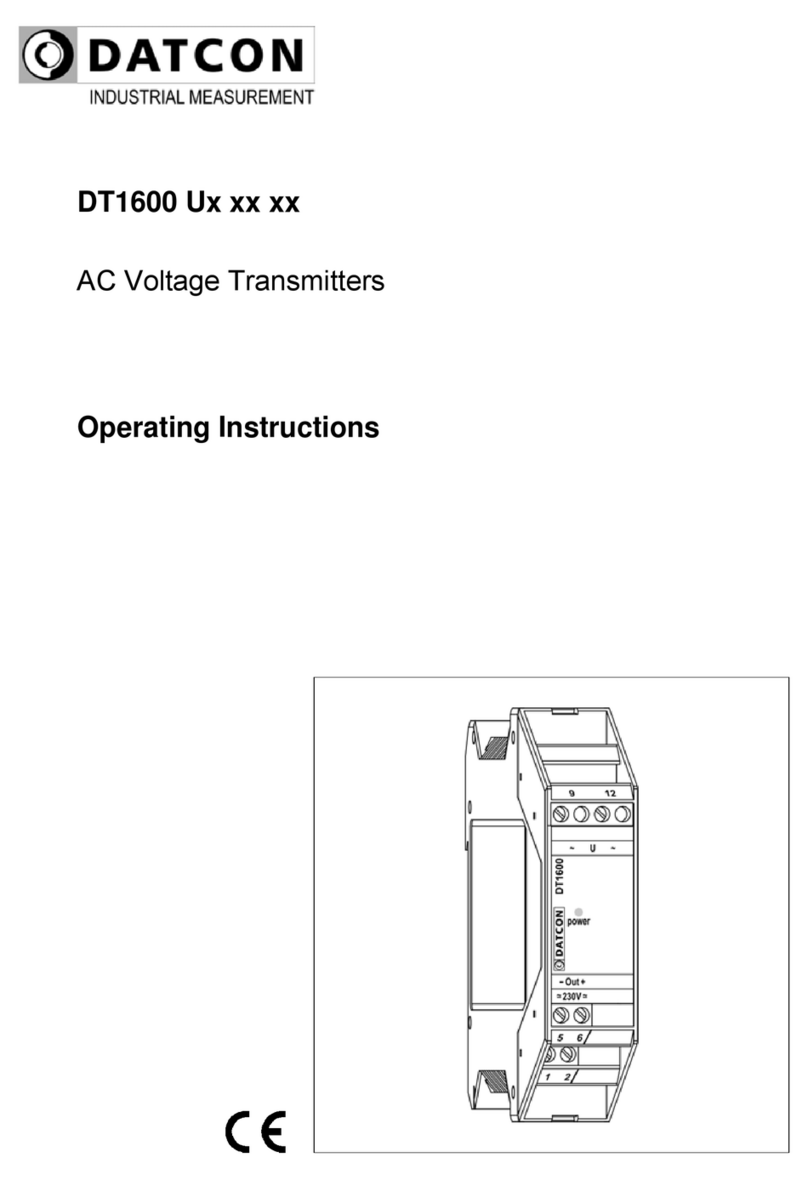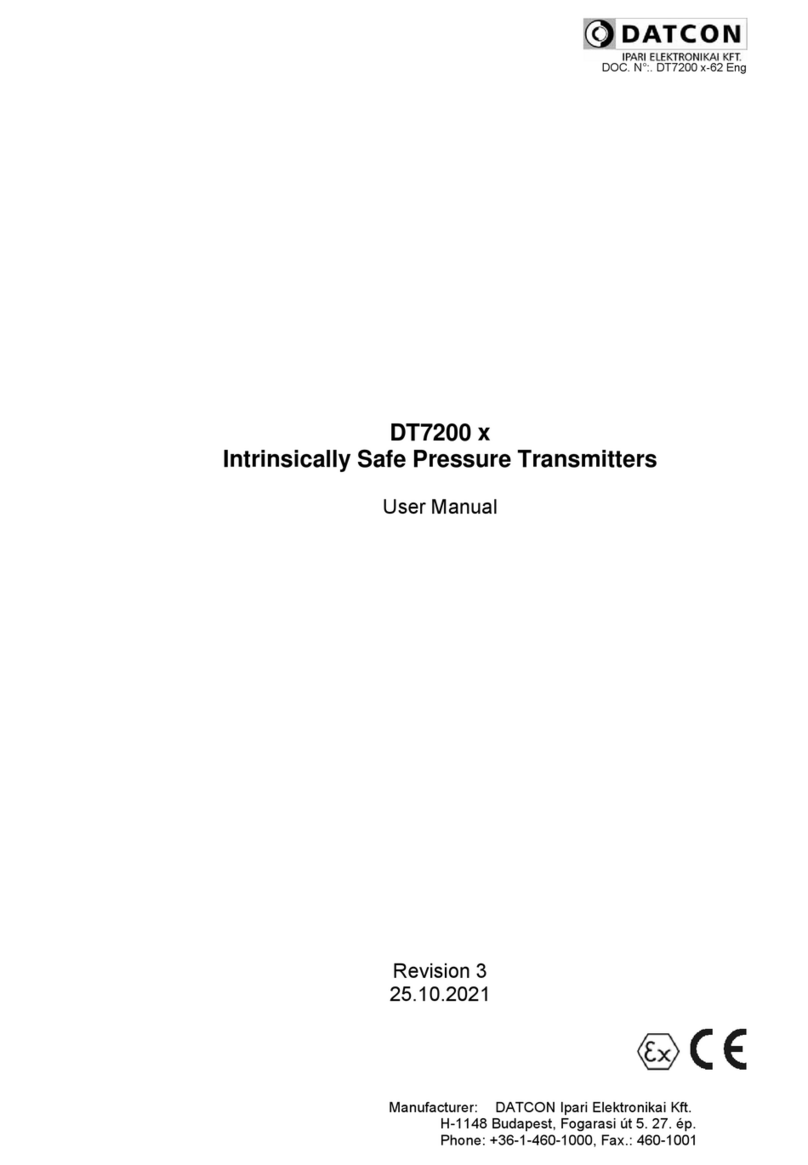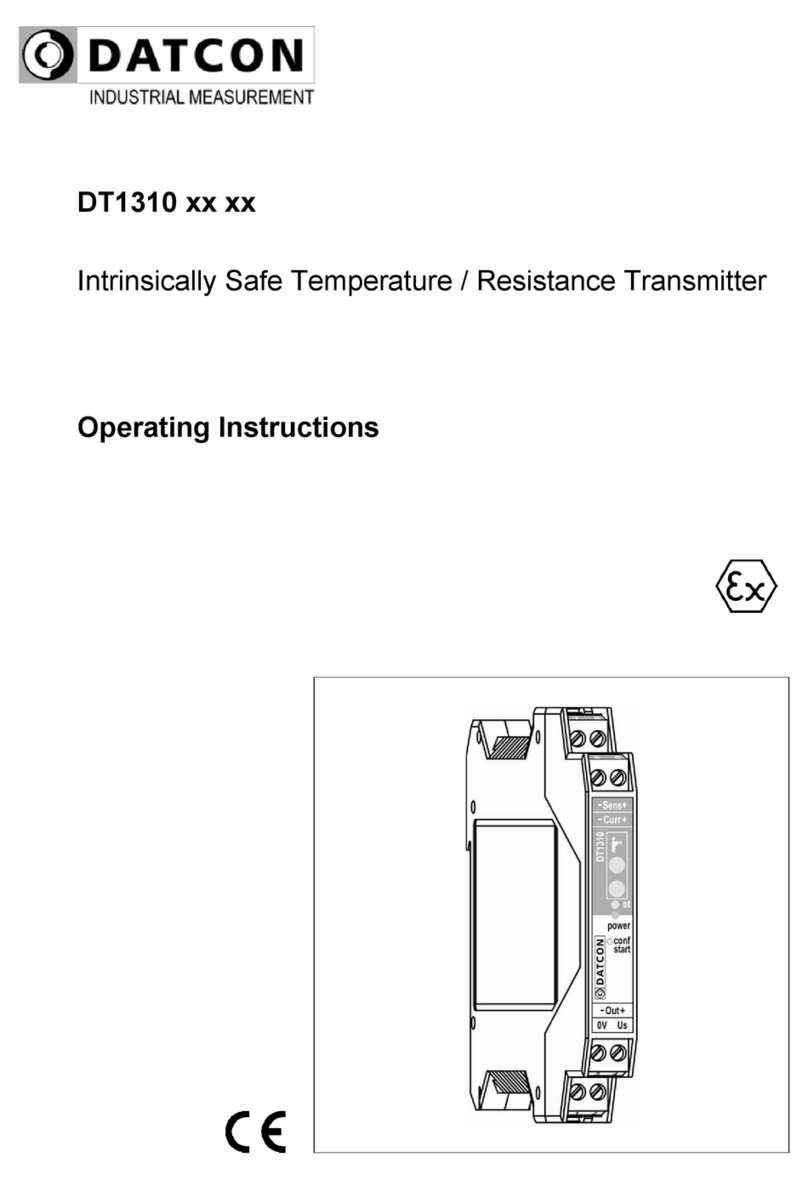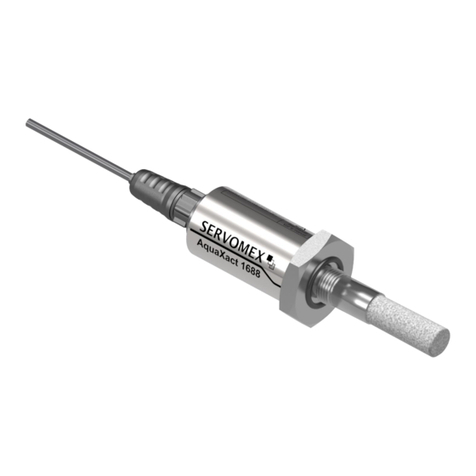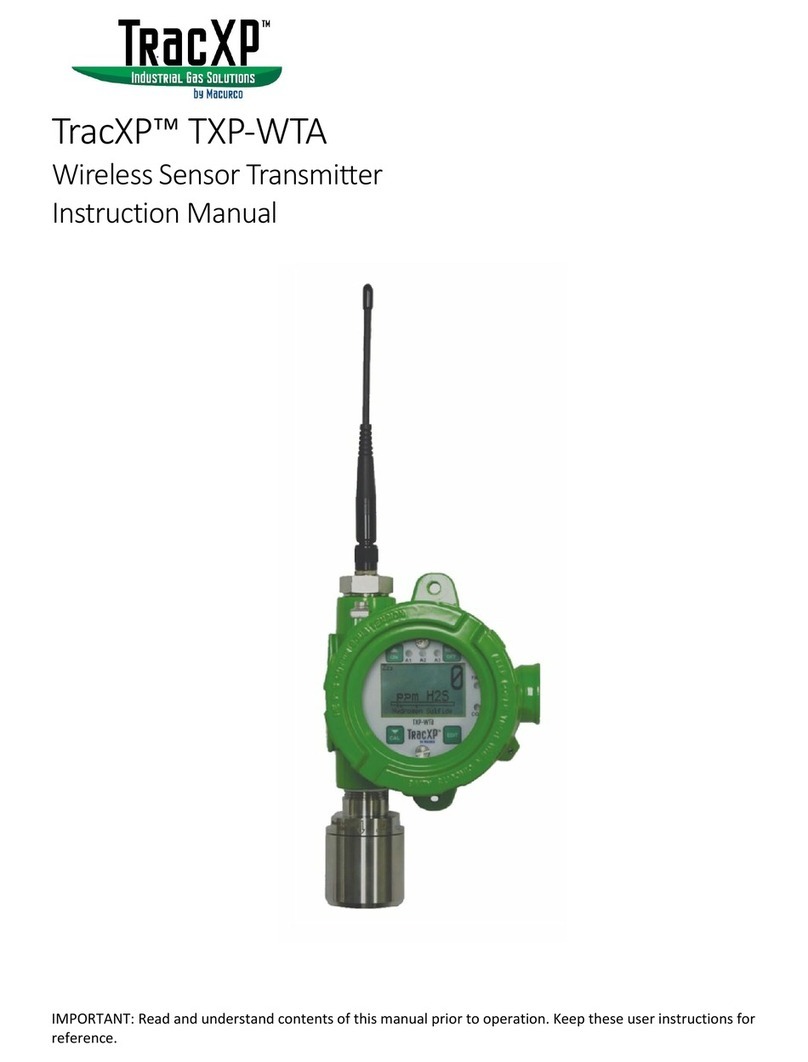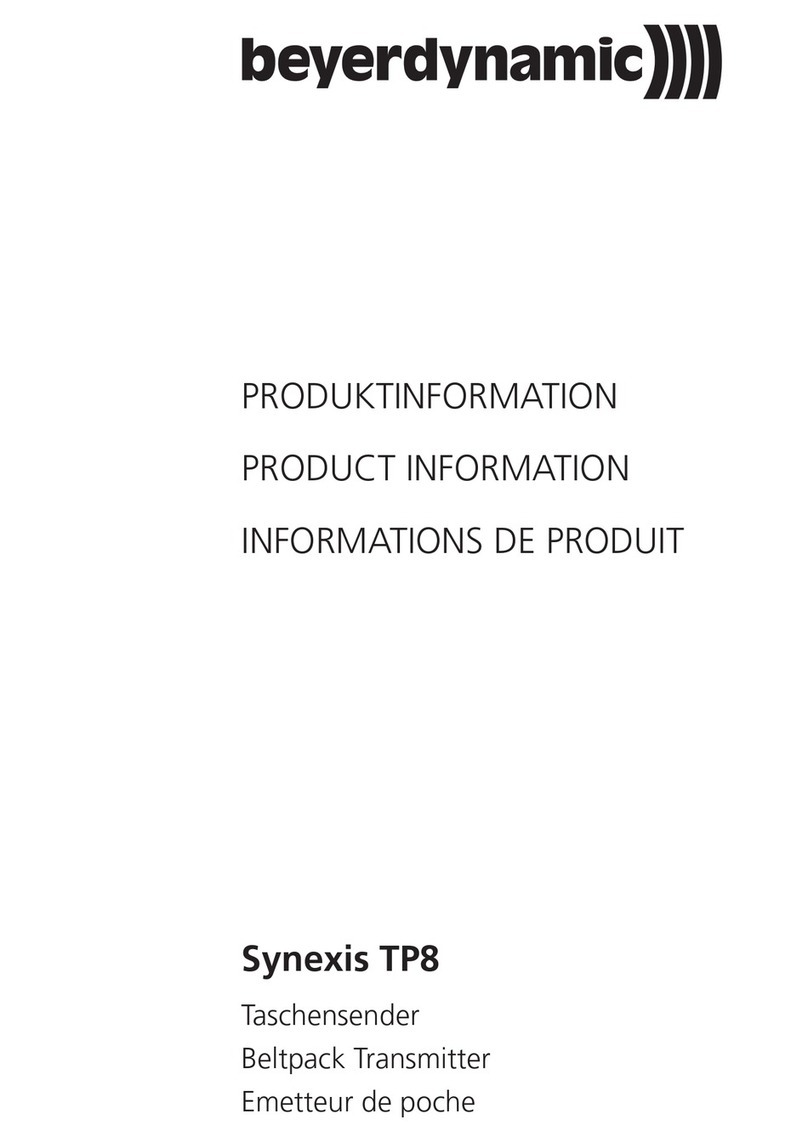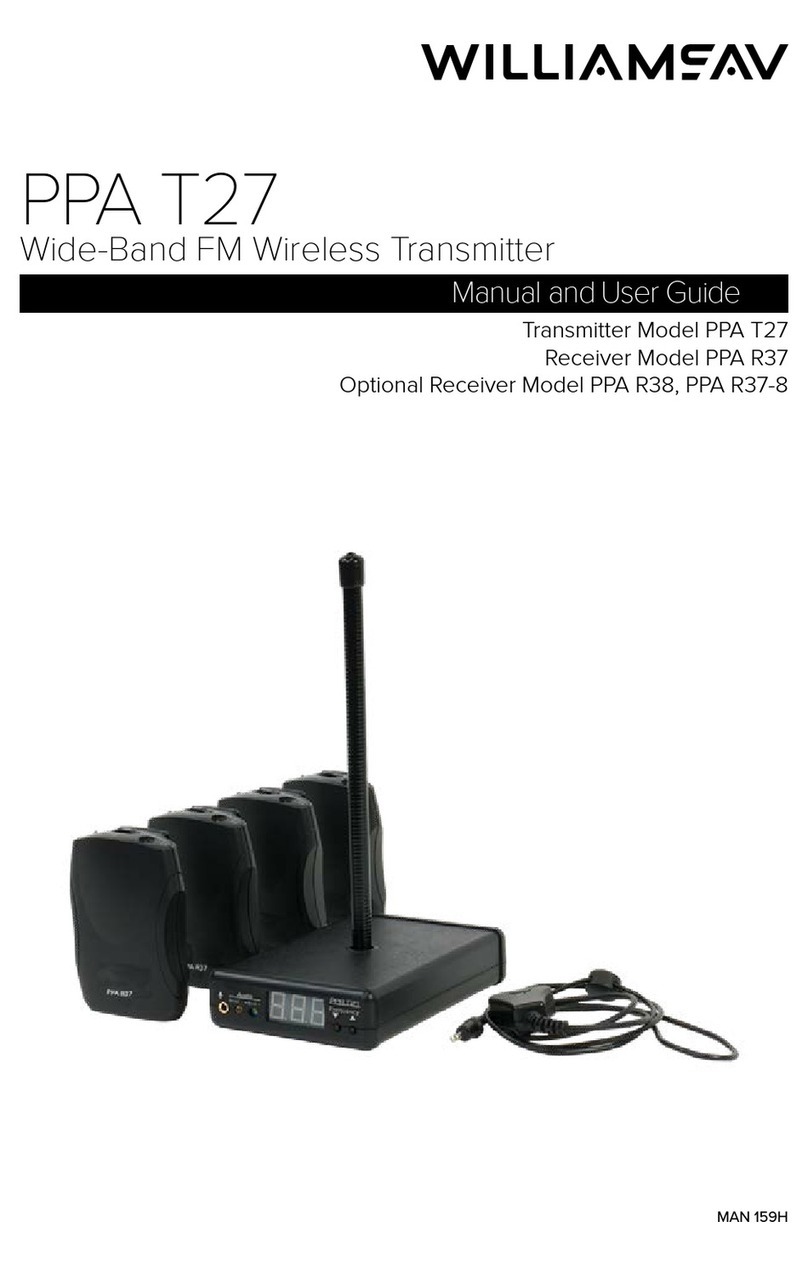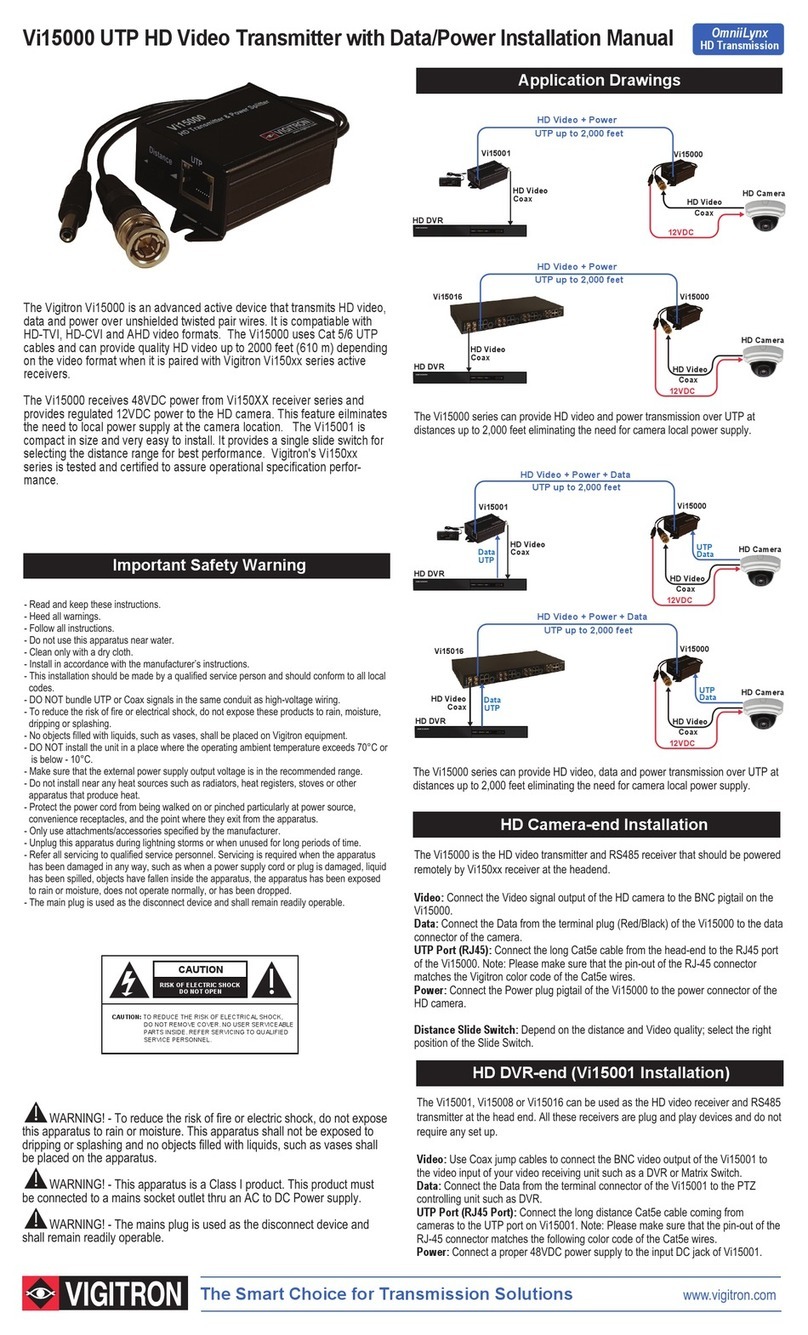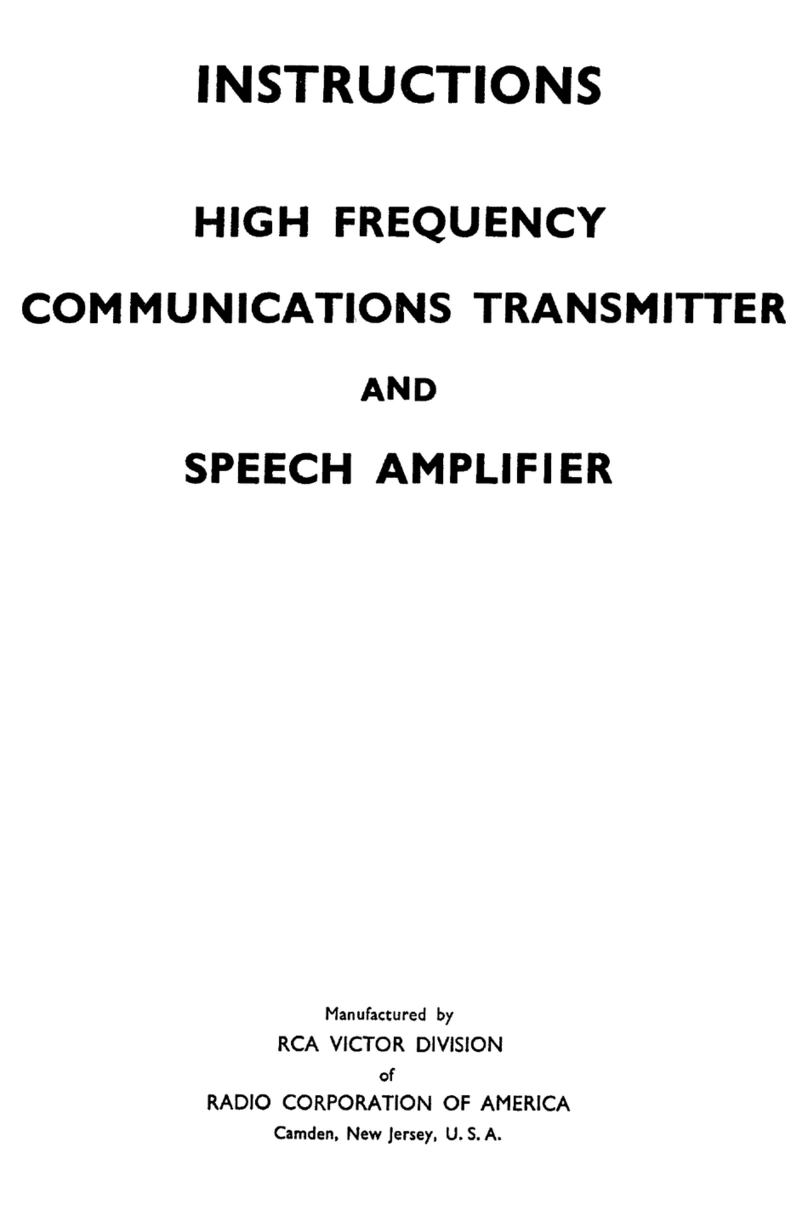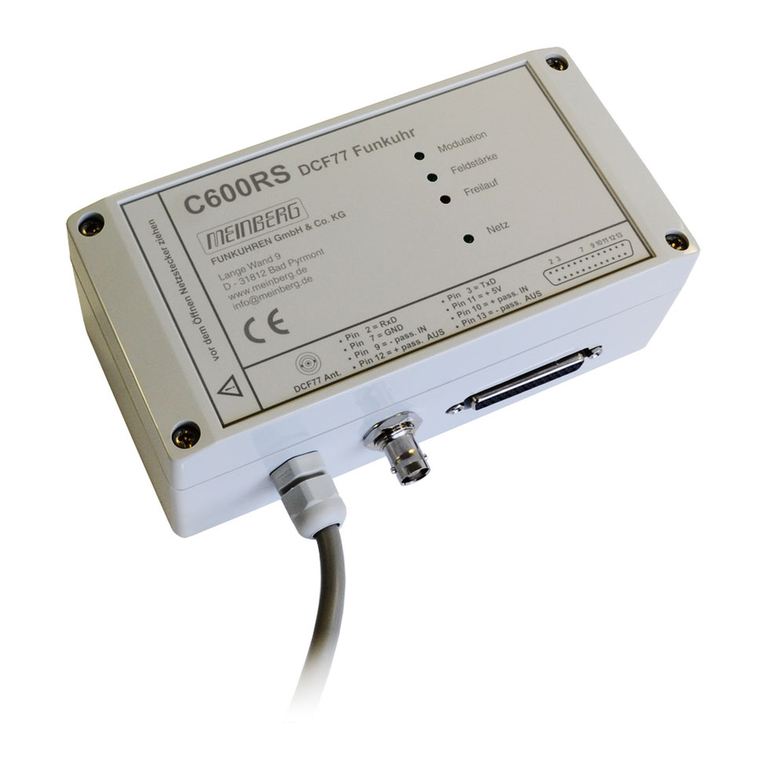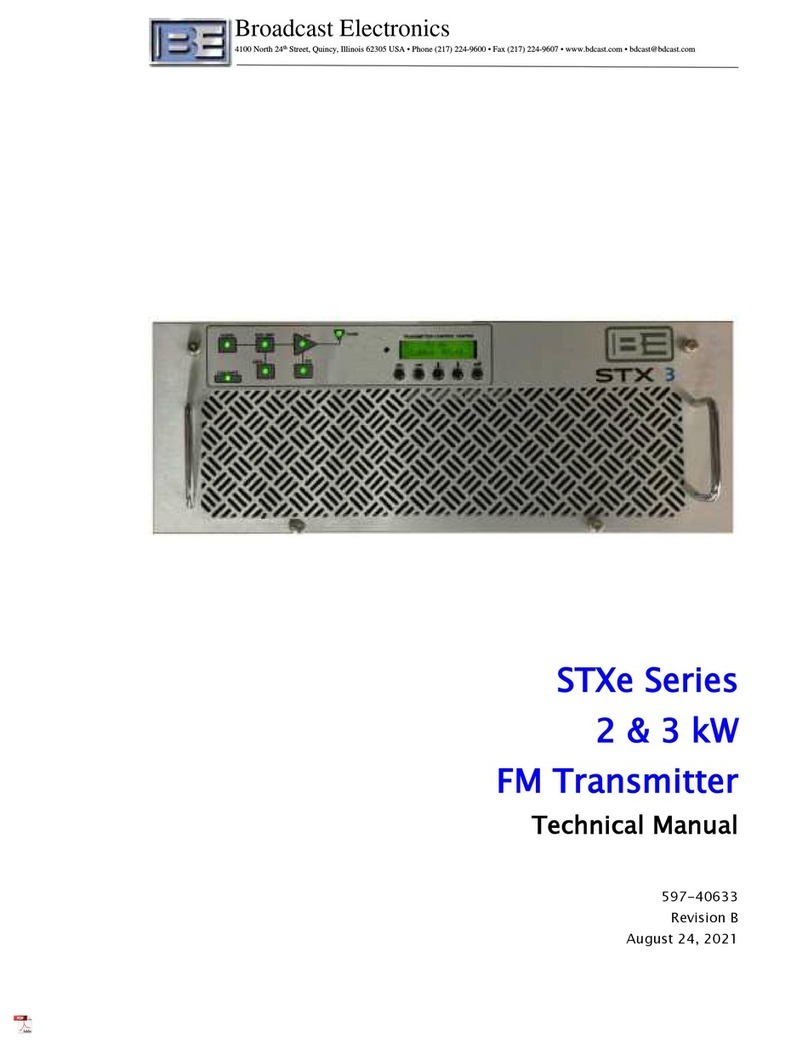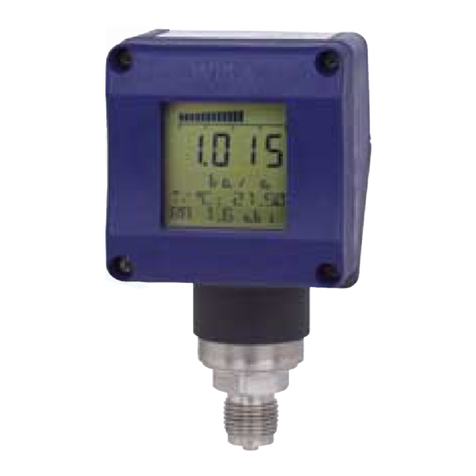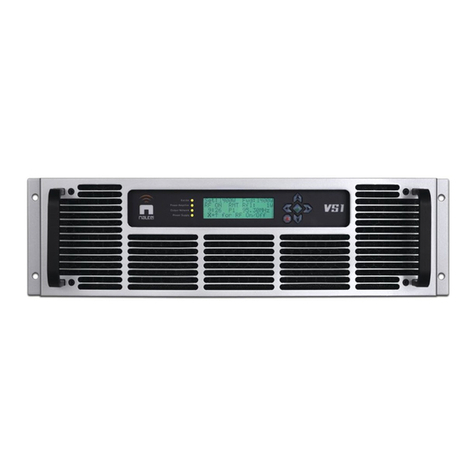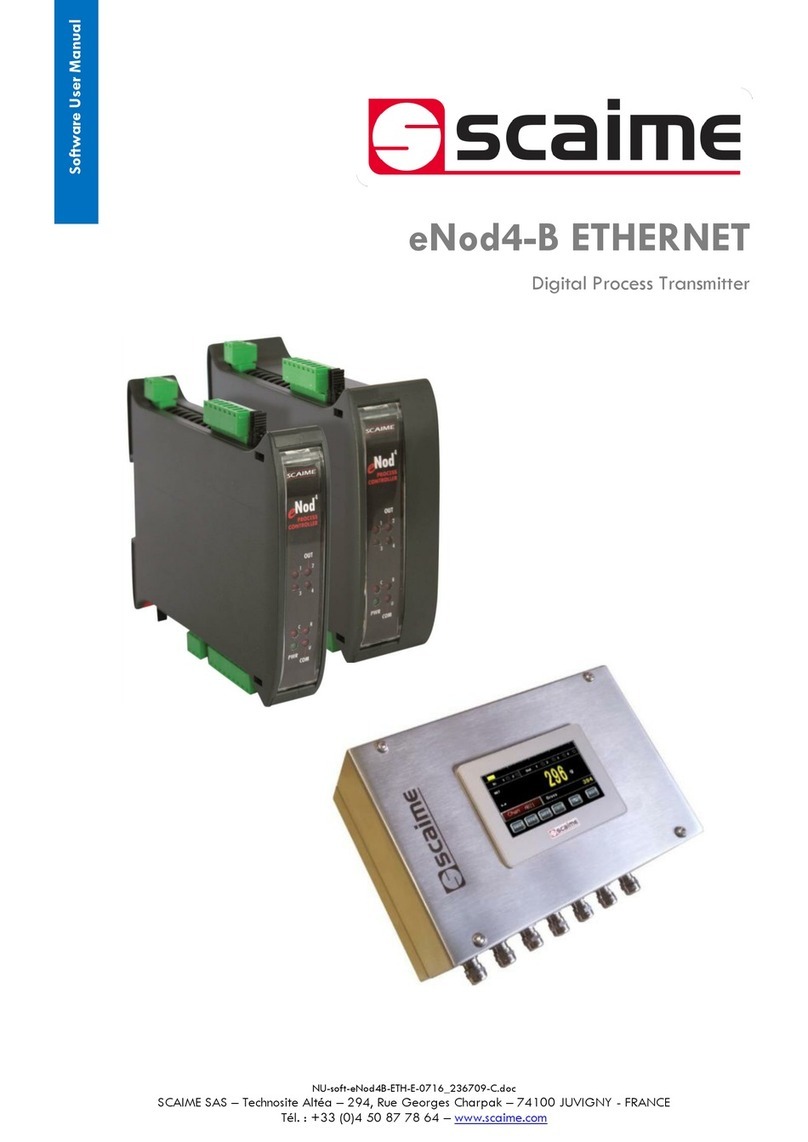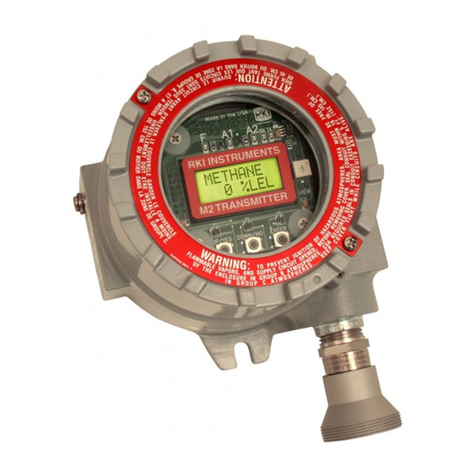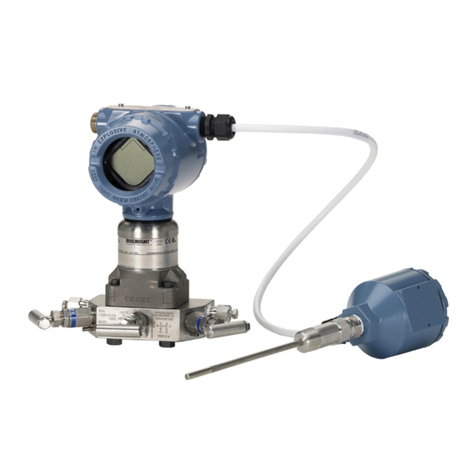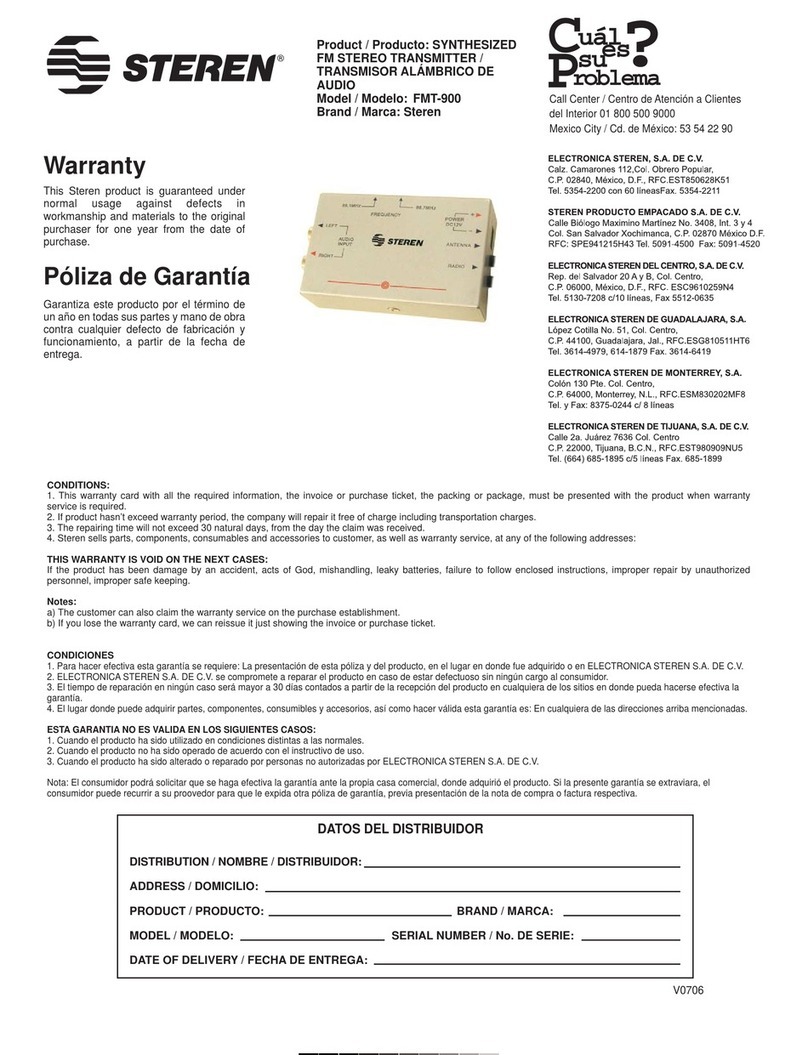Datcon DT1010 Series User manual

DT1010 xx xx
Temperature / Resistance / Potentiometer Transmitter
Operating Instructions

DT1010 xx xx
2 20180403-V1
Contents
1. About this document.....................................................4
1.1. Function ................................................................................... 4
1.2. Target group............................................................................. 4
1.3. Symbolism used....................................................................... 4
2. For your safety...............................................................5
2.1. Authorized personnel ............................................................... 5
2.2. Appropriate use........................................................................ 5
2.3. Warning about misuse ............................................................. 5
2.4. General safety instructions....................................................... 5
2.5. CE conformity........................................................................... 5
2.6. Environmental instructions....................................................... 5
3. Product description.......................................................6
3.1. Delivery configuration............................................................... 6
3.2. Type designation...................................................................... 6
3.3. Principle of operation ............................................................... 7
3.4. Adjustment ............................................................................... 7
3.5. Indicators, USB connector ....................................................... 8
3.6. Storage and transport .............................................................. 9
4. Mounting.......................................................................10
4.1. General instructions ............................................................... 10
4.2. Main dimensions of the instrument ........................................ 10
4.3. Mounting ................................................................................ 11
5. Connecting ...................................................................12
5.1. Preparing the connection ....................................................... 12
5.2. Connecting sensor / resistor / potentiometer to the input....... 13
5.3. Connecting the signal processing unit and the power supply 14
5.4. Put the instrument under supply voltage................................ 14
6. The first start-up, indicators .......................................15
6.1. The first start-up ..................................................................... 15
6.2. Indicators................................................................................ 16

DT1010 xx xx
20180403-V1 3
7. Setting-up .....................................................................17
7.1. First steps............................................................................... 17
7.2. Connecting wire setting.......................................................... 18
7.3. Input mode setting.................................................................. 19
7.4. Analogue output setting ......................................................... 20
7.5. Error current / voltage setting................................................. 20
7.6. Setting averaging ................................................................... 21
7.7. Output refresh time setting..................................................... 23
7.8. Analogue output scaling......................................................... 24
7.9. Two wire zeroing .................................................................... 25
7.10. Sensor correction values...................................................... 26
7.11. Potentiometer calibrating ..................................................... 28
7.12. Potentiometer scaling........................................................... 30
7.13. New password setting .......................................................... 31
7.14. Resetting default settings..................................................... 32
7.15. Analogue output limiting....................................................... 33
7.16. Analogue output error state disabling .................................. 33
8. Fault rectification.........................................................34
8.1. Fault finding............................................................................ 34
8.2. Repairing................................................................................ 34
9. Dismounting.................................................................35
9.1. Dismounting procedure .......................................................... 35
9.2. Disposal ................................................................................. 35
10. Appendix.....................................................................36
10.1. Technical specification ......................................................... 36
10.2. Application example ............................................................. 38

DT1010 xx xx
4 20180403-V1
1. About this document
1.1. Function
This operating instructions manual has all the information
you need for quick set-up and safe operation of
DT1010 xx xx.
Please read this manual before you start setup.
1.2. Target group
This operating instructions manual is directed to trained
personnel. The contents of this manual should be made
available to these personnel and put into practice by them.
1.3. Symbolism used
Information, tip, note
This symbol indicates helpful additional information.
Caution, warning, danger
This symbol informs you of a dangerous situation that could
occur. Ignoring this cautionary note can impair the person
and/or the instrument.
•List
The dot set in front indicates a list with no implied sequence.
→Action
This arrow indicates a single action.
1
Sequence
Numbers set in front indicate successive steps in a
procedure.

DT1010 xx xx
20180403-V1 5
2. For your safety
2.1. Authorized personnel
All operations described in this operating instructions
manual must be carried out only by trained and authorized
specialist personnel. For safety and warranty reasons, any
internal work on the instruments must be carried out only by
DATCON personnel.
2.2. Appropriate use
The DT1010 xx xx is a Temperature / Resistance /
Potentiometer Transmitter. Detailed information on the
application range is available in chapter 3. Product
description.
2.3. Warning about misuse
Inappropriate or incorrect use of the instrument can give rise
to application-specific hazards, or damage to system
components through incorrect mounting or adjustment.
2.4. General safety instructions
The DT1010 xx xx is a high-tech instrument requiring the
strict observance of standard regulations and guidelines.
The user must take note of the safety instructions in this
operating instructions manual, the country-specific
installation standards as well as all prevailing safety
regulations and accident prevention rules.
2.5. CE conformity
The DT1010 xx xx is in conformity with the provisions of the
following standards:
EN 61010-1 (safety)
EN 61326 (EMC)
2.6. Environmental instructions
Protection of the environment is one of our most important
duties.
Please take note of the instructions written in the following
chapters:
•Chapter 3.6. Storage and transport
•Chapter 9.2. Disposal

DT1010 xx xx
6 20180403-V1
3. Product description
3.1. Delivery configuration
Delivered items The scope of delivery encompasses:
•DT1010 xx xx
•documentation:
this operating instructions
certification
warranty
3.2. Type designation

DT1010 xx xx
20180403-V1 7
3.3. Principle of operation
Area of application
Principle of operation
The DT1010 xx xx Temperature / Resistance /
Potentiometer Transmitter provide signal transmission and
conversion between sensor or resistance / potentiometer
and signal processing unit.
The transmitter feature complete 3-way isolation: the input
to output and both to the power supply circuits are isolated.
The output signal may be:
0-20 mA, 4-20 mA, 0-10 V, 2-10 V.
The sensor / resistance / potentiometer can be connected to
the input either with 2 / 3 or 4 wire.
The module features complete configuration of sensor input
variables and process signal outputs.
Some of the configuration options are: sensor type,
resistance range, signal output scaling, 2 / 3 or 4 wire
measuring mode, signal filtering, calibrated sensor curve
fitting, etc. The configuration software is capable of storing
all the parameters for future re-configurations.
The configuration parameters are downloaded from
the PC to the DT1010 xx xx via USB port.
The measuring current flows through the sensor / resistance
/ potentiometer connected to the input. The voltage drop on
the measuring sensor is compared with the voltage drop on
the internal reference resistor. The voltage difference is led
to a 21 bit A/D converter. The digital output signal of the
A/D converter is processed by a microcontroller.
The microcontroller produces a pulse width modulated
output signal which is proportional to the processed, scaled
measuring value. The output pulse is galvanic isolated by
an opto coupler. After filtering the pulse is converted into
analogue current or voltage signal.
Connecting the instrument to the PC through the USB
interface the instrument’s communication circuitry come into
active state and it is ready for communication with the
configuration software.
Power supply The instrument works from a 19-35 VDC supply voltage.
The power consumption is 1.6 W.
3.4. Adjustment
After connecting the DT1010 xx xx is ready to work with the
factory default parameters are written in Chapter 6.1.. For
working with the default parameters there is no need any
adjustment. The detailed description of the setup can be
found in Chapter 7..

DT1010 xx xx
8 20180403-V1
3.5. Indicators, USB connector
The following figure shows the indicators and the USB
connector on the instruments front:
1. The „power” green indicator has two function:
- continuous light indicates that the instrument is in
measuring mode
- a short flash indicates that a successful communication
has granted with the configuration software.
2. „st” red indicator has two function:
- continuous light indicates that the instrument is in
configuration mode
- blinking light indicates different error states
3. USB-B mini, 5 pole connector for connecting to the PC at
configuration.

DT1010 xx xx
20180403-V1 9
3.6. Storage and transport
This instrument should be stored and transport in places
whose climatic conditions are in accordance with chapter
10.1. Technical specifications, as described under the
title: Environmental conditions.
The packaging of DT1010 xx xx consist of environment-
friendly, recyclable cardboard is used to protect the
instrument against the impacts of normal stresses occurring
during transportation. The corrugated cardboard box is
made from environment-friendly, recyclable paper. The
inner protective material is nylon, which should be disposed
of via specialized recycling companies.

DT1010 xx xx
10 20180403-V1
4. Mounting
4.1. General instructions
The instrument should be installed in a cabinet with
sufficient IP protection, where the operating conditions are
in accordance with chapter 10.1. Technical specification,
as described under the title: Operating conditions.
Mounting position
The instruments are designed in a housing for mounting on
TS-35 rail.
The instruments should be mounted in vertical position
(horizontal rail position).
Horizontal mounting may cause overheating and damage of
the instrument.
4.2. Main dimensions of the instrument

DT1010 xx xx
20180403-V1 11
4.3. Mounting
The following figure shows the mounting procedures (fixing
on the rail):
Mounting on the rail
The mounting doesn’t need any tool.
1. Tilt the instrument according to the figure; put the
instrument’s mounting hole onto the upper edge of the rail
(figure step 1.).
2. Push the instrument’s bottom onto the bottom edge of the
rail (figure step 2.), you will hear the fixing assembly
closing.
3. Check the hold of the fixing by moving the instrument
firmly.

DT1010 xx xx
12 20180403-V1
5. Connecting
5.1. Preparing the connection
Select and prepare
connection cable
Always observe the following safety instructions:
• The connection must be carried out by trained and
authorized personnel only!
• Connect only in the complete absence of supply voltage
• Use only a screwdriver with appropriate head
Take note the suitability of the connecting cable
(wire cross-section, insulation, etc.).
The wire cross-section should be 0.25-1.5 mm2.
You may use either solid conductor or flexible conductor.
In case of using flexible conductor use crimped wire end.
For the input connection we recommended to use screened
cable. It’s an important rule that the power cables and signal
cables should lead on a separate way.

DT1010 xx xx
20180403-V1 13
5.2. Connecting sensor / resistor / potentiometer to the
input
The following figure shows the wiring plan, connecting the
sensor / resistor / potentiometer to the input:
Wiring plan, connecting
the sensor / resistor /
potentiometer to the
input
(see also “Application
example”)
Checking the
Connections
1. Loosen terminal screws.
2. Insert the wire ends into the open terminals according to
the wiring plan.
3. Screw the terminal in.
4. Check the hold of the wires in terminals by pulling on
them firmly.
Check if the cables are connected properly (have you
connected all the cables, have you connected to the right
place, do not the cable-ends touch each other).

DT1010 xx xx
14 20180403-V1
5.3. Connecting the signal processing unit and the
power supply
The following figure shows the wiring plan, connecting the
signal processing unit and the power supply:
Wiring plan, connecting
the signal processing
unit and the power
supply
(see also “Application
example”)
Be careful the polarity of
the cables
Checking the
connections
1. Loosen terminal screws.
2. Insert the wire ends into the open terminals according to
the wiring plan.
3. Screw the terminal in.
4. Check the hold of the wires in terminals by pulling on
them firmly.
Check if the cables are connected properly (have you
connected all the cables, have you connected to the right
place, do not the cable-ends touch each other).
The connection is finished.
5.4. Put the instrument under supply voltage
Put the instrument
under supply voltage
After you have completed the connections, put the
instrument under supply voltage. If the connection is correct
the green indicator gives light and you can measure an
output signal according to the measured value on the input.

DT1010 xx xx
20180403-V1 15
6. The first start-up, indicators
6.1. The first start-up
After connecting the DT1010 xx xx is ready to work with the
factory default parameters.
When you are going to use other parameters you should
set-up the instrument according to Chapter 7.
Factory default settings:
•Sensor connecting 4 wire.
•Measuring mode: temperature measurement.
•Current output: 4-20 mA.
•Current output error value: 3.2 mA.
•Averaging: 16 measurement.
•Output refresh time: 0.5 sec.
•Sensor characteristics fitting mode: off.
•Output scaling: -200.0 °C ÷ 4 mA-t; +800.0 °C ÷ 20 mA.
•Password:”1000”.
•Wire resistance in 2 wire connecting: 0 Ohm.
•Potentiometer measurement mode and scaling:
0% ÷ 0.00, 100% ÷ 100.00. (for potentiometer measurement
first you should calibrate the potentiometer according:
Chapter 7.)

DT1010 xx xx
16 20180403-V1
6.2. Indicators
(1) power (green): mode an communication indicator
(2) st. (red): mode and error indicator
The two indicator gives information in conjunction as
follows:
•Measurement mode:
power: light, st.: dark.
•Error state:
power: light, st.: blinking.
The number of blinkings gives the error information while
the output current is forced into 3.2 mA or 20.8 mA
(depends on setting).
1 blink: fatal error. (repairing: in factory service only).
2 blinks: input break (repairing: check the sensor and
wiring).
3 blinks: potentiometer mode is selected but the
potentiometer is not calibrated (see Chapter 7.)
4 blinks: measuring value out of range.
5 blinks: analog output scaling error (the instrument is
unable to convert the measured value into the 3.9-20.1 mA
range, while the output current is forced to 3.2 mA or
20.8 mA, depends on setting). (see Chapter 7.)
•Configuration mode:
After connecting the instrument to the PC USB port, starting
the configuration program and opening the proper virtual
serial port, the instrument is ready to communicate with the
program (for selecting the proper virtual port begin with the
last and than try the others).
st.: light, power: short flash in a case when a successful
communication has granted.

DT1010 xx xx
20180403-V1 17
7. Setting-up
7.1. First steps
Necessary tools For setting-up you need:
•mini USB B (5 pin)-USB A cable
•USB driver install program
•DT1010_DT1310 v2013-09-18 - 2015-03-25.exe
configuration software
•PC
Install the virtual COM
port diver You have to install once the virtual COM driver before use
the configuration program first. This driver provides the USB
port interface as a simple serial port for the configuration
program. The driver is located in folder ‘DT1010\USB
Driver’. Install this driver.
Software Easy to use DT1010_DT1310 v2013-09-18 - 2015-03-
25.exe configuration software (free of charge). Simple copy
it into an optional folder, click on the “Start” button and you
can configure the instrument.
Setting-up 1. Connect the instrument with the USB cable to the PC
USB port and put it under supply voltage.
2. Start the configuration program.
3. Select the appropriate serial port.
4. Click on the „Open Serial Port” button.
5. st. (red) indicator gives light, signing that the instrument is
configuration mode.
6. power (green) indicator signs with a short flash the
successful communication between the program and the
instrument.
7. Use the configuration software as is written on the
following pages.
8. At the end of the settings click on the “Download settings”
button, the new settings are written into the instrument.
9. Click on the „Close Serial Port” button for finishing the
configuration procedure and disconnect the USB cable.

DT1010 xx xx
18 20180403-V1
7.2. Connecting wire setting
Function The sensor / resistance / potentiometer can be connected to
the input either with 4 / 3 / 2 wire.
The 4 wire connection gives the best result: the instrument
is able to compensate the connecting cable resistances.
The 3 wire mode is a compromise it may give a good result
when all the 3 wire have same resistance.
The two wire mode is the cheapest mode, use only when
there is no other possibility.
[Factory default: 4 wire.]
1. Select the appropriate connecting wire mode by clicking
the button.
The figure shows the factory default setting.
Sequence of operations
Warning! Select always appropriate wiring mode.
Inappropriate selection may cause measuring error.

DT1010 xx xx
20180403-V1 19
7.3. Input mode setting
Function The instrument has four measuring modes:
• temperature
•potentiometer %
•potentiometer scaled
• resistance
[Factory default: temperature measurement.]
1. Select the appropriate input mode by clicking the button.
The figure shows the factory default setting.
Sequence of operations
•Temperature transmitter, measured in °C, with
0.1°C resolution [Factory default].
•Potentiometer transmitter, measured in percent between
0-100%, with 1% resolution.
•Potentiometer transmitter with scaled output, with
selectable number of decimals (between 1-4).
•Resistance transmitter, measured in ohm with two
decimal resolution.
Note: before selecting potentiometer mode it should
calibrate the potentiometer. The calibrating means it should
be define the start and the end points of the potentiometers
wiper.

DT1010 xx xx
20 20180403-V1
7.4. Analogue output setting
Function The output signal can be current: 0 / 4-20 mA, or
voltage 0 / 2-10 V. (should be specified at order)
[Factory default: 4-20 mA]
1. Select the appropriate output signal by clicking the
button.
The figure shows the factory default setting.
Sequence of operations
Note:
It is recommended to use 4-20 mA.
It’s advantages:
•wire break can be detected by the signal processing unit.
•it can drive a loop-indicator (e.g. DT4200)
7.5. Error current / voltage setting
Function In a case of an error state the output current / voltage is
forced into error state. The value of the error current /
voltage can be set:
Current: 3.2 mA or 21 mA
Voltage: 1.6 V or 10.5 V
[Factory default: 3.2 mA]
1. Select the appropriate output signal by clicking the
button.
The figure shows the factory default setting.
Sequence of operations
Note:
In a case of 0-20 mA output current the error current is 21
mA, independent from setting.
Other Datcon Transmitter manuals
